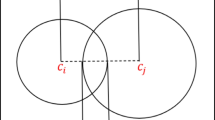Abstract
Operation sequencing in CAPP aims at determining the optimal order of machining operations with minimal machining cost and satisfying all the precedence constraints. The genetic algorithm (GA) is widely used to solve precedence constrained operation sequencing problem (PCOSP) due to its efficiency and parallel processing capability. How to guarantee the precedence constraints is always a hot research topic and there are mainly two classes of methods. The first ones use additional adjustment approaches to repair the infeasible solutions that break precedence constraints. It is unreliable and low efficient. The second ones avoid infeasible solutions in initialization through some encoding approaches such as topological storing based encoding approach, but the premature convergence problem may occur facing some complicated PCOSPs. To solve these problems, an edge selection strategy based GA is proposed. The edge selection based strategy could produce feasible solutions in initialization, and assures that every feasible solution will be generated with acceptable probability so as to improve GA’s converging efficiency. Then the precedence constraints are kept by order crossover. Modified mutation operator is designed to optimize the selection of machine tool, tool access direction and cutting tool for each operation. The experiments illustrate that the proposed algorithm is effective and efficient.













Similar content being viewed by others
References
Amaitik, S., & Kiliç, S. E. (2007). An intelligent process planning system for prismatic parts using STEP features. The International Journal of Advanced Manufacturing Technology, 31(9–10), 978–993. doi:10.1007/s00170-005-0269-5.
Chen, C.-F., Wu, M.-C., Li, Y.-H., Tai, P.-H., & Chiou, C.-W. (2013). A comparison of two chromosome representation schemes used in solving a family-based scheduling problem. Robotics and Computer-Integrated Manufacturing, 29(3), 21–30.
Cho, D., Lee, Y., Lee, T., & Gen, M. (2014). An adaptive genetic algorithm for the time dependent inventory routing problem. Journal of Intelligent Manufacturing, 25(5), 1025–1042. doi:10.1007/s10845-012-0727-5.
Costa, A., Cappadonna, F., & Fichera, S. (2015). A hybrid genetic algorithm for minimizing makespan in a flow-shop sequence-dependent group scheduling problem. Journal of Intelligent Manufacturing. doi:10.1007/s10845-015-1049-1.
Deja, M., & Siemiatkowski, M. (2013). Feature-based generation of machining process plans for optimised parts manufacture. Journal of Intelligent Manufacturing, 24(4), 831–846. doi:10.1007/s10845-012-0633-x.
Ding, L., Yue, Y., Ahmet, K., Jackson, M., & Parkin, R. (2005). Global optimization of a feature-based process sequence using GA and ANN techniques. International Journal of Production Research, 43(15), 3247–3272. doi:10.1080/00207540500137282.
Eremeev, A. V. (2012). A genetic algorithm with tournament selection as a local search method. Journal of Applied and Industrial Mathematics, 6(3), 286–294. doi:10.1134/S1990478912030039.
Goldberg, D. E., & Bridges, C. L. (1990). An analysis of a reordering operator on a GA-hard problem. Biological Cybernetics, 62(5), 397–405. doi:10.1007/BF00197646.
Hua, G.-R., Zhou, X.-H., & Ruan, X.-Y. (2007). GA-based synthesis approach for machining scheme selection and operation sequencing optimization for prismatic parts. The International Journal of Advanced Manufacturing Technology, 33(5), 594–603.
Huang, W., Hu, Y., & Cai, L. (2012). An effective hybrid graph and genetic algorithm approach to process planning optimization for prismatic parts. The International Journal of Advanced Manufacturing Technology, 62(9–12), 1219–1232. doi:10.1007/s00170-011-3870-9.
Jiménez, P. (2013). Survey on assembly sequencing: A combinatorial and geometrical perspective. Journal of Intelligent Manufacturing, 24(2), 235–250. doi:10.1007/s10845-011-0578-5.
Kafashi, S. (2011). Integrated setup planning and operation sequencing (ISOS) using genetic algorithm. The International Journal of Advanced Manufacturing Technology, 56(5–8), 589–600. doi:10.1007/s00170-011-3202-0.
Koulamas, C. (1993). Operation sequencing and machining economics. International Journal of Production Research, 31(4), 957–975. doi:10.1080/00207549308956769.
Laporte, G., Riera-Ledesma, J., & Salazar-González, J. (2003). A branch-and-cut algorithm for the undirected traveling purchaser problem. Operations Research, 51(6), 940–951.
Lee, D. H., Kiritsis, D., & Xirouchakis, P. (2001). Search heuristics for operation sequencing in process planning. International Journal of Production Research, 39(16), 3771–3788. doi:10.1080/00207540110061922.
Lee, S., Soak, S., Kim, K., Park, H., & Jeon, M. (2008). Statistical properties analysis of real world tournament selection in genetic algorithms. Applied Intelligence, 28(2), 195–205. doi:10.1007/s10489-007-0062-2.
Li, F., Yang, J., & Jin, C. (2012). A Strategy of genetic operations based on schema. In D. Jin & S. Lin (Eds.), Advances in computer science and information engineering (Vol. 168, pp. 489–494, Advances in intelligent and soft computing). Berlin: Springer.
Li, S., Liu, Y., Li, Y., Landers, R., & Tang, L. (2013). Process planning optimization for parallel drilling of blind holes using a two phase genetic algorithm. Journal of Intelligent Manufacturing, 24(4), 791–804. doi:10.1007/s10845-012-0628-7.
Li, W. D., Ong, S. K., & Nee, A. Y. C. (2002a). Hybrid genetic algorithm and simulated annealing approach for the optimization of process plans for prismatic parts. International Journal of Production Research, 40(8), 1899–1922. doi:10.1080/00207540110119991.
Li, W. D., Ong, S. K., & Nee, A. Y. C. (2002b). Recognizing manufacturing features from a design-by-feature model. Computer-Aided Design, 34(11), 849–868.
Li, W. D., Ong, S. K., & Nee, A. Y. C. (2004). Optimization of process plans using a constraint-based tabu search approach. International Journal of Production Research, 42(10), 1955–1985.
Li, Y., & Gong, S. H. (2003). Dynamic ant colony optimisation for TSP. International Journal of Advanced Manufacturing Technology, 22(7–8), 528–533. doi:10.1007/s00170-002-1478-9.
Liang, Z., & Xiaohang, Y. (2011). Operations sequencing in flexible production lines with Bernoulli machines. IEEE Transactions on Automation Science and Engineering, 8(3), 645–653. doi:10.1109/TASE.2011.2109061.
Lin, C.-J., & Wang, H.-P. (1993). Optimal operation planning and sequencing: Minimization of tool changeovers. International Journal of Production Research, 31(2), 311–324.
Liu, Q., Ullah, S., & Zhang, C. (2011). An improved genetic algorithm for robust permutation flowshop scheduling. The International Journal of Advanced Manufacturing Technology, 56(1–4), 345–354. doi:10.1007/s00170-010-3149-6.
Liu, X.-J., Yi, H., & Ni, Z.-H. (2013). Application of ant colony optimization algorithm in process planning optimization. Journal of Intelligent Manufacturing, 24(1), 1–13.
Liu, Z., & Wang, L. (2007). Sequencing of interacting prismatic machining features for process planning. Computers in Industry, 58(4), 295–303.
Moghaddam, M. J., Soleymani, M. R., & Farsi, M. A. (2015). Sequence planning for stamping operations in progressive dies. Journal of Intelligent Manufacturing, 26(2), 347–357. doi:10.1007/s10845-013-0788-0.
Moon, C., Kim, J., Choi, G., & Seo, Y. (2002). An efficient genetic algorithm for the traveling salesman problem with precedence constraints. European Journal of Operational Research, 140(3), 606–617.
Nallakumarasamy, G., Srinivasan, P. S. S., Venkatesh Raja, K., & Malayalamurthi, R. (2011). Optimization of operation sequencing in CAPP using simulated annealing technique (SAT). The International Journal of Advanced Manufacturing Technology, 54(5–8), 721–728. doi:10.1007/s00170-010-2977-8.
Novkovic, S., & Šverko, D. (1998). The minimal deceptive problem revisited: The role of “genetic waste”. Computers and Operations Research, 25(11), 895–911.
Potvin, J.-Y. (1996). Genetic algorithms for the traveling salesman problem. Annals of Operations Research, 63(3), 337–370. doi:10.1007/BF02125403.
Qiao, L., Wang, X. Y., & Wang, S. C. (2000). A GA-based approach to machining operation sequencing for prismatic parts. International Journal of Production Research, 38(14), 3283–3303. doi:10.1080/002075400418261.
Reddy, S., Shunmugam, M., & Narendran, T. (1999). Operation sequencing in CAPP using genetic algorithms. International Journal of Production Research, 37(5), 1063–1074.
Salehi, M., & Bahreininejad, A. (2011). Optimization process planning using hybrid genetic algorithm and intelligent search for job shop machining. Journal of Intelligent Manufacturing, 22(4), 643–652. doi:10.1007/s10845-010-0382-7.
Sun, X., Chu, X., Su, Y., & Tang, C. (2010). A new directed graph approach for automated setup planning in CAPP. International Journal of Production Research, 48(22), 6583–6612. doi:10.1080/00207540903307615.
Tseng, Y.-J., Kao, H.-T., & Huang, F.-Y. (2009). Integrated assembly and disassembly sequence planning using a GA approach. International Journal of Production Research, 48(20), 5991–6013. doi:10.1080/00207540903229173.
Wang, B., Guan, Z., Ullah, S., Xu, X., & He, Z. (2014). Simultaneous order scheduling and mixed-model sequencing in assemble-to-order production environment: A multi-objective hybrid artificial bee colony algorithm. Journal of Intelligent Manufacturing. doi:10.1007/s10845-014-0988-2.
Whitley, D., Starkweather, T., & Shaner, D. (1991). The traveling salesman and sequence scheduling: Quality solutions using genetic edge recombination. In L. Davis (Ed.), Handbook of genetic algorithms (pp. 350–372). New York: Department of Computer Science, Colorado State University.
Xu, P., & Wang, L. (2014). An exact algorithm for the bilevel mixed integer linear programming problem under three simplifying assumptions. Computers and Operations Research, 41(1), 309–318. doi:10.1016/j.cor.2013.07.016.
Yun, Y., Chung, H., & Moon, C. (2013). Hybrid genetic algorithm approach for precedence-constrained sequencing problem. Computers and Industrial Engineering, 65(1), 137–147. doi:10.1016/j.cie.2011.11.019.
Yun, Y., & Moon, C. (2011). Genetic algorithm approach for precedence-constrained sequencing problems. Journal of Intelligent Manufacturing, 22(3), 379–388. doi:10.1007/s10845-009-0296-4.
Yusof, Y., & Latif, K. (2014). Survey on computer-aided process planning. The International Journal of Advanced Manufacturing Technology, 75(1–4), 77–89. doi:10.1007/s00170-014-6073-3.
Zhang, W., Gen, M., & Jo, J. (2014). Hybrid sampling strategy-based multiobjective evolutionary algorithm for process planning and scheduling problem. Journal of Intelligent Manufacturing, 25(5), 881–897. doi:10.1007/s10845-013-0814-2.
Acknowledgments
This paper is supported by National Natural Science Foundation of China (Grant No. 51475290, Grant No. 51075261), Research Fund for the Doctoral Program of Higher Education of China (No. 20120073110096) Shanghai Science and Technology Innovation Action Plan (No. 11DZ1120800).
Author information
Authors and Affiliations
Corresponding author
Rights and permissions
About this article
Cite this article
Su, Y., Chu, X., Chen, D. et al. A genetic algorithm for operation sequencing in CAPP using edge selection based encoding strategy. J Intell Manuf 29, 313–332 (2018). https://doi.org/10.1007/s10845-015-1109-6
Received:
Accepted:
Published:
Issue Date:
DOI: https://doi.org/10.1007/s10845-015-1109-6




